A home typical home network consists of many different components, such as: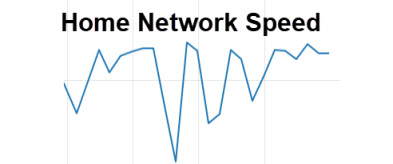
- Wi-Fi Router
- Wi-Fi Extenders
- Homeplug adapters
- Ethernet cards
- Wi-Fi Cards
- Ethernet Switches.
There are many different ways that these components can be connected together, and each of these components will have an impact on the overall speed on your home network.
The following connection technologies and their approximate speeds are shown below:
Ethernet Using Cable (UTP)- Ethernet Adaptors
Current common Ethernet Speeds are:
- 100Mbps
- 1000Mbps =1Gbps -Common for home networking
- 10000Mbps =10Gbps
Wi-Fi Speeds
| Standard | Theoretical | Typical |
| 802.11an- Wi-Fi 4 | 600Mbps | 100Mbps |
| 802.11ac- Wi-Fi 5 | 1300Mbps | 200Mbps |
| 802.11ax- Wi-Fi 6 | 10Gbps | 2Gbps |
Taken form Lifewire
Powerline
| Standard | Theoretical | Typical Maximum |
| av200 | 200Mbps | 80Mbps |
| av500 | 500Mbps | 250Mbps |
| av1200 | 1.2Gbps | 400Mbps |
Internet Speeds
| Low | Medium | High |
| 15Mbps | 50Mbps | 70Mbps *note1 |
note1– All fibre connections have a top speed of around 300Mbps
Home Network Traffic and Design Guidelines
Just like traffic on roads network traffic flows predominately in a certain direction.
For traffic on roads the flow is usually heavy into and out of cities, and you will notice that the size of the roads reflects this.
On home networks the flow is predominately to and from the Internet, and so your network design should also reflect this.
However if you look at the tables above you can see that the slowest Ethernet, the slowest Wi-Fi and the slowest powerline are all usually faster than the fastest Internet speed.
Therefore for most home networks the main reason for slow connections is the Internet speed, and not the local network.
So when considering exchanging equipment for speed reasons you should be aware of this fact.
However it may not always be the case!
To illustrate we will look at a couple of example network topologies and answer a few questions regarding speeds and improvements.
Example 1
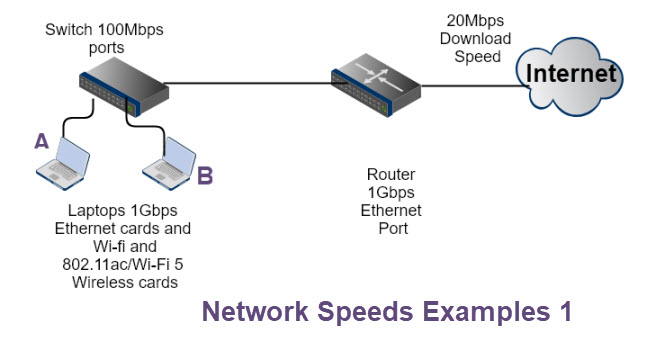
Referring to the network diagram above answer the following questions:
Q1- What is the maximum download speed from the Internet?
Q2- What is the maximum transfer speed between laptops A and B?
Q3- Would upgrading the switch to a 1Gbps switch improve the Internet download speed.
Q4 -Would adding a Wi-Fi hub (802.11ac- Wi-Fi 5) improve the Internet download speed.
Q5- Would adding a Wi-Fi hub (802.11ac- Wi-Fi 5) improve the transfer speed between laptops A and B?
Q6 -If we now Upgrade the Internet connection to fast fibre 70Mbps what would now be the maximum Internet download speed be for laptops A and B.
Answers Exercise 1
A1- 20 Mbps limited by the Internet Connection
A2- 100 Mbps limited by the switch.
A3- No
A4- No
A5- Yes could possibly get 200Mbps
A6- 70 Mbps limited by the Internet Connection
Example 2
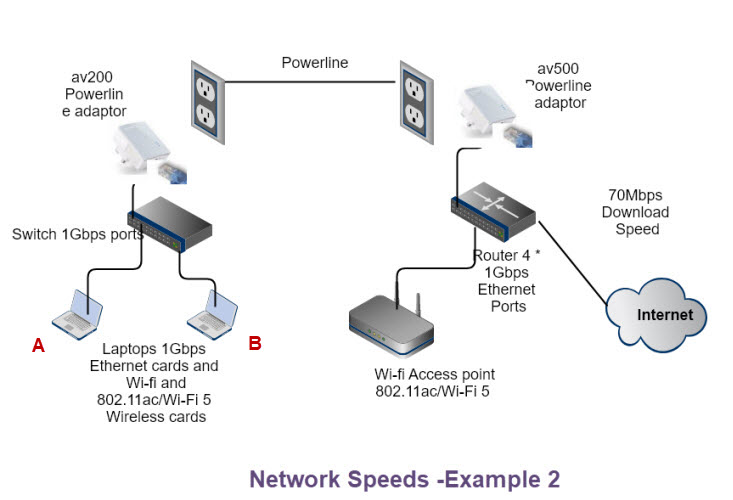
Referring to the network diagram above (example 2) answer the following questions:
Q1- What is the maximum download speed from the Internet?
Q2- What is the maximum transfer speed between laptops A and B?
Q3- Would upgrading the AV200 homeplug adaptor improve the Internet download speed.
Q4 -Would connecting over the Wi-Fi hub (802.11ac- Wi-Fi 5) improve the Internet download speed.
Q5- Would adding a Wi-Fi hub (802.11ac- Wi-Fi 5) improve the transfer speed between laptops A and B?
Answers Exercise 2
A1- 70 Mbps limited by the Internet Connection
A2- 1 Gbps limited by the switch.
A3- Perhaps- The speed over the link is limited by the AV200 and is close to the maximum Internet speed and depending on the home wiring may be less so an upgrade might be considered.
A4- No as it would still have the 70Mbps limit
A5- No it would make it slower
Measuring Your Home Network Speed
Most people are familiar with Internet speed checks. These are all done using a web browser and rely on a server on the Internet that sends and receives data from the browser.
To do the same on a local network requires that you have a server located somewhere on your local network that does the same as the ones on the Internet.
Because of this requirement local network speed checks aren’t so easy to perform.
There are many free speed testing utilities available but the iperf utility is the only one that runs on windows, Linux, Pi, Android and IOS.
The only negative with it is that it uses the command line.
Here are a few screen shots that show the effect of distance on Wi-Fi speed.
Using Iperf3
You first need to start the server on a machine on the network. I used a raspberry pi connected directly to my home router as it allowed me to test various parts of the network to the gateway.
Note: the pi 3 is limited to 100Mb/sec.
The command is:
iperf3 -s -p 5201
You then need to start the sender on another machine using the command
iperf3 -c -p 5201 -t 5
the -t 5 means run 5 tests
an Interesting and very useful option is-J which give the output as JSON.
iperf3 -c -p 5201 -J -t 5
Example Tests
For the following tests the server was on a laptop connected by Wi-Fi and the client on a windows machine connected via Ethernet cable through a 100Mbps switch.
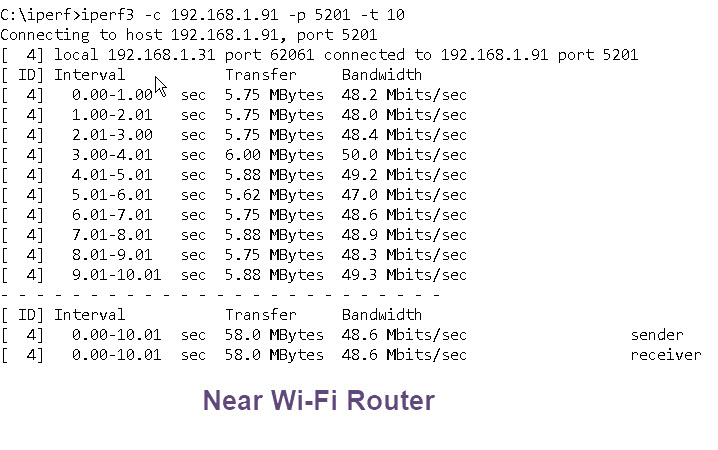
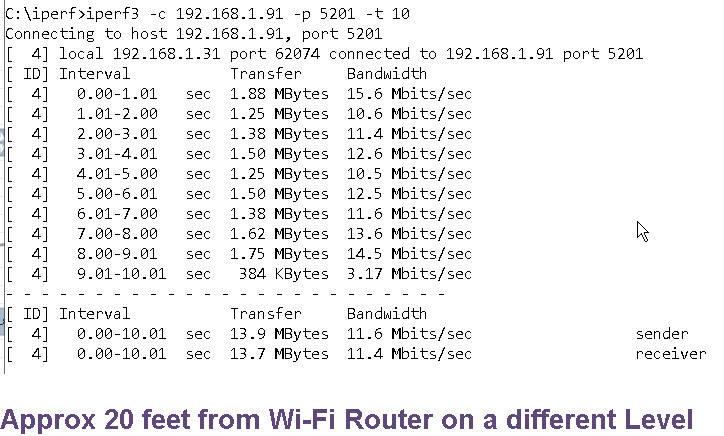
You can clearly see the how the speed reduces as you move away from the Access point.
Batch Script
Unfortunately there is no run forever switch so if you want to do tests over an extended period then it is difficult.I create this simple batch script that will run until interrupted and sends results to a file results.log.
You need to change the timeout if you want to change the run period currently it will run a test every 30 secs.
:Loop REM Put your batch file's code here. @echo Started: %date% %time% >>results.log @echo off iperf3 -c pi2.home -p 3000 >>results.log @echo off timeout 30 GOTO :Loop
Node Red Flow
I have created a node-red flow which will run tests every 5 minutes and produce a graph as shown below.
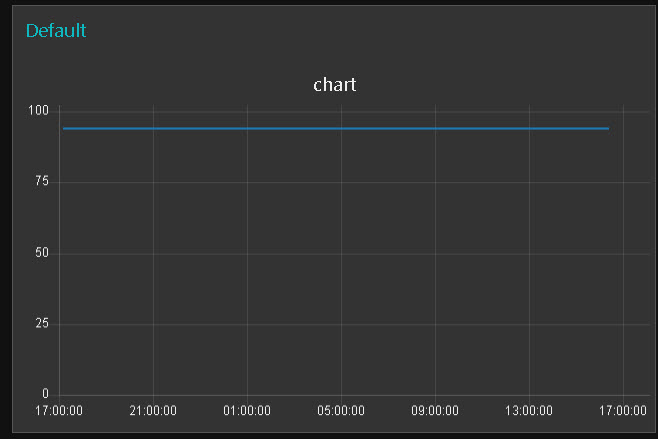
Download Flow
Common Questions and Answers
Q -Is it possible to monitor home network traffic?
A- Windows has a network monitor utility (part of task manager) which shows you the network activity on that machine only. Similar tools exist for Linux.
Packet sniffing applications like Wireshark will show you the network activity on that particular switch segment but not across the entire network.
Summary
It is important to be aware of the different home networking technologies and their possible speeds when laying out your home network.
You should also note that speeds using Wi-Fi in particular but also homeplug can vary considerably.
As Internet speeds improve the home network design could limit your Internet Download speeds.
Because of the way switches work monitoring your total network traffic isn’t really possible.
Resources and Related Tutorials
- Internet Speeds Explained
- Monitor Internet Speeds with Speedtest-cli and Node-Red
- Basic Home Network Hardware Components, Devices and Services
- Review of home networking speed test tools.
- Using iperf3
- How to create a guest network

Is the powerline system used anywhere in the United states?My internet speed was 0.675 Mbps it is now up to 10. Mbps slow
It is a home networking technology used world wide but not on the Internet
Rgds
Steve
Are the answers to question 2 in Examples 1 & 2 the wrong way round?
In Example 1, the switch is 100 Mbps and the answer to Q2 says it is 1 Gbps?
Likewise, in Example 2, the switch is 1 Gbps and the answer to Q2 says it is 100 Mbps.
Is this correct or have ‘I’ got it wrong?
No. I got it wrong I will change it.
Tks
Steve